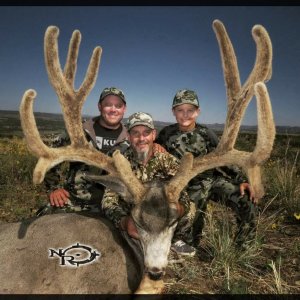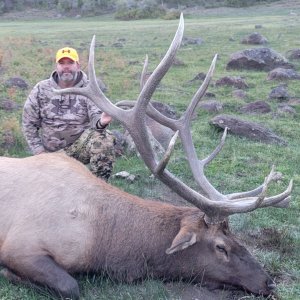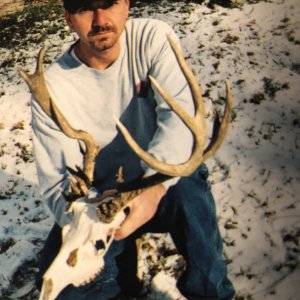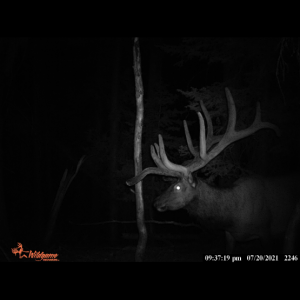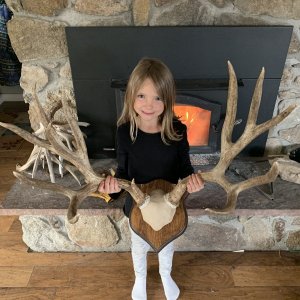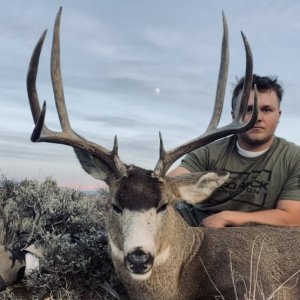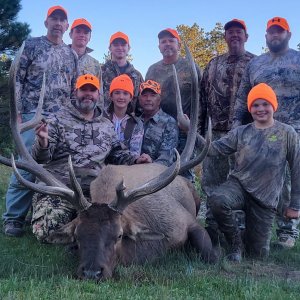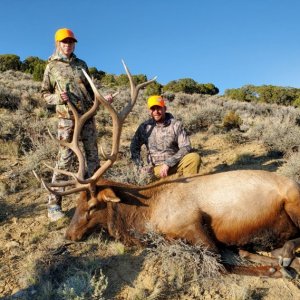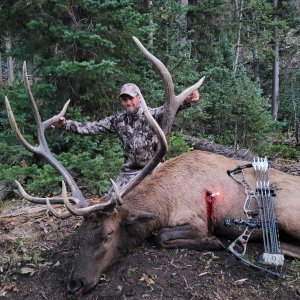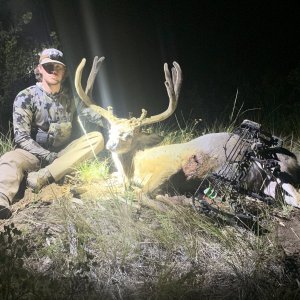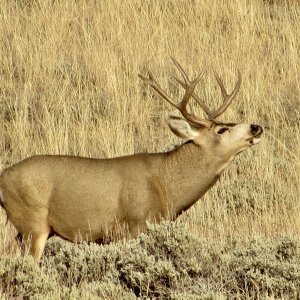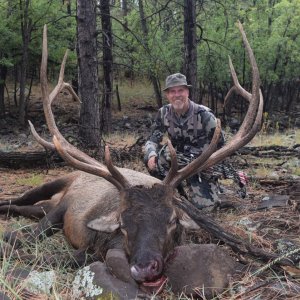Below is the article off of the website; finally something that backs up what sportsman are seeing in the field. The other point here is that HUMANS are one of the prime predators of mule deer......you cannot continue to shoot does and 70% of the yearling buck populations and think we are somehow going to get back to the good ole' days. I even remember back a few months ago when a biology student suggested that the "modern" research in deer biology indicated that we needed to shoot MORE does to get MORE deer and bigger bucks....its not habitat, just stop shooting so many deer and control the predators a little bit and the deer will come back...it really isn't that complicated. Here is the article:
Research shows predators can significantly impact deer during drought
A crew of biologists, veterinarians and volunteers watched from the narrow spine of the ridge top as the helicopter worked in the steep ravine below chasing a mule deer at ground level on the rugged eastern slopes of the Four Peaks.
At an opening in the vegetation when the deer was fully visible, David Conrad, a veteran biologist with the Arizona Game and Fish Department, leaned out the copter?s door with his specially designed gun and shot a weighted net over the racing mule deer doe.
The helicopter quickly pivoted and flew back. David Rigo, the ?mugger? for that particular netgun operation, eased out the door onto the helicopter?s skids, then nimbly jumped to the ground, hustled to the deer, immobilized it, and fitted it with blinders to help keep it calm.
The helicopter landed. Conrad and the pilot got into the act helping to secure then load the 90-pound deer into the helicopter for a short flight to the waiting group on the ridge top above.
The helicopter net gun capture on March 13-14 was part of an Arizona Game and Fish Department research effort to capture 15 deer and fit them with radio tracking collars as part of a long-term deer study in the 3-Bar Wildlife Area near Roosevelt Lake. The study?s findings so far indicate that predators may have a more significant impact on deer populations than biologists previously thought.
The prevailing biological belief is that habitat conditions are the primary controlling factor for deer populations, not predation. This long-term deer study in the 3-Bar is punching holes in parts of that biological theory and others.
Research Chief Jim deVos says the findings have many biologists scratching their heads. ?Despite a prolonged drought, we are seeing deer densities within our predator-proof enclosure rivaling those in places like the prime whitetail country of the southeastern United States. Yet deer densities outside the 3-Bar enclosure are plummeting,? says deVos.
Professor Warren Ballard with Texas Tech, one of the principal researchers on the department's deer study, says, ?Deer numbers inside the enclosure are around 10-times higher than the surrounding country. One of our challenges is determining all the factors of why that is so.?
Professor Paul Krausman, a renowned wildlife biologist with the University of Arizona, is also involved in the long-term research project.
3-Bar is a unique outdoor laboratory
The 602-acre Walnut Canyon Enclosure in the 3-Bar Wildlife Area is located in the Tonto National Forest. The Walnut Canyon Enclosure is a fenced area of almost one-square mile that provides a unique outdoor wildlife laboratory for biologists.
This predator-proof enclosure has been used for more than 30 years to study mule deer declines and for other research as well. Two mule deer declines have been documented in the western United States since the 1960s. The exact reasons for declines are varied and often difficult to pinpoint.
"The original 3-Bar mule deer study in the late 1970s found that fawn survival was 30-percent greater inside the enclosure than outside during a six-year wet period. The current 3-Bar study shows that despite one of the worst droughts in the last 700 to 1,000 years, fawn survival has remained high in this predator-proof enclosure,? says deVos.
Outside the enclosure during the drought, fawn survival rates and mule deer populations have plunged to the lowest numbers in the past half-century.
During 2002?which was the driest year in Arizona?s recorded history ?the fawn-to-doe ratios within the enclosure were 100 fawns per 100 does. Outside the enclosure in Game Management Unit 22 the ratio was 18 fawns per 100 does. ?The only significant difference between the two areas is the absence of predators in the 3-Bar enclosure,? Ballard says.
Deer capture helps research efforts
Ballard says the recent deer capture provided an opportunity to assess deer nutritional conditioning as part of the process to better understand the interaction between habitat quality, deer nutritional condition, predation and fawn survival.
Eight deer were captured inside the enclosure and seven deer in the habitat outside the enclosure. The captured deer were fitted with radio telemetry collars so biologists can track them and determine their habitat use. The radio collars will also send out a ?mortality signal,? so that biologists can determine the cause of death.
A student working on his doctorial thesis in wildlife biology at Texas Tech, Rugilio Carrera, is conducting the vegetative analysis both inside and outside the enclosure for comparison sake on a seasonal basis.
Carrera, an exchange student from Mexico, says one question he is trying to answer is whether the high density of mule deerwithin the enclosure is negatively impacting the vegetation.
A prevailing wildlife biological belief is that deer numbers can reach a density at which they will negatively impact the vegetation, such as on the Kaibab Plateau during the 1930s. A browse line (as tall as a deer can reach and eat standing on its hind legs) can still be discerned today on the Kaibab in northern Arizona.
DeVos says a non-scientific appraisal of the 3-Bar habitat is that the deer are not impacting the vegetation. ?Some of the top wildlife biologists in the field, such as Dave Brown, have looked at the habitat and not readily detected overuse by deer. The threshold of when deer densities impact habitat may be much higher than we ever believed possible, at least in this habitat type.?
Portable ultrasound used to assess deer nutrition
Dr. Ole Alcumbrac, a wildlife veterinarian working with the department on the project, used a portable ultrasound machine during the deer capture-and-release operation to determine the thickness of each deer?s layer of fat. The ultrasound machine also allowed Alcumbrac and Scott Bender, a veterinarian with the Navajo Nation who was helping on the capture effort, to determine whether or not the does captured were pregnant. All but two does were pregnant and most were carrying twins.
"The ultrasound equipment allows us to do a body fat assessment on live animals. In the past, we could only collect such information on dead deer, usually at check stations during the fall hunts. The new technology gives us real-time data on live deer,? Alcumbrac says.
Carrera explains that vegetation quality and quantity data are being collected from the 3-Bar study site quarterly during spring, summer, autumn, and winter. Biologists are measuring vegetation inside and outside the enclosure to observe possible changes in habitat quality on an annual and seasonal basis.
Annual deer drive conducted
"Once a year, we conduct a deer survey where every animal is counted. Therefore, we know exactly how many deer are in the enclosure, including how many fawns, does and bucks. We even know their ages,? deVos says.
Deer are counted during a deer drive each fall using 60-100 Game and Fish Department employees, interns and volunteers. ?We form a long human line across the entire enclosure and walk from one end to the other. Each animal that passes through the line along the way is counted. Believe me, it's not an easy task because most of the enclosure has steep rocky terrain with dense vegetation, including lots of Cholla cactus,? says deVos.
3-Bar study challenges accepted biological theories
The 3-Bar deer study findings challenge many accepted biological theories.
For instance, deVos says, biologists have long believed that deer are ?density? dependent, which means that once deer densities ratios get high, deer experience a reduction in fecundity ? the physical ability to reproduce. ?That's not happening on the 3-Bar. That tells us that density dependency may not be a valid theory or that the threshold for it is much higher than anyone thought.?
Another generally accepted biological theory is that habitat conditions control deer numbers, not predation. ?That theory may be true when weather and habitat conditions are good, such as our study during the 1970s in the 3-Bar. However, we have had a decade-long drought with an exclamation point in 2002?the driest year in recorded history?yet deer numbers, densities and fawn reproduction have remained as high as during the wet years. The absence of predation is the only variable that has changed,? deVos says.

